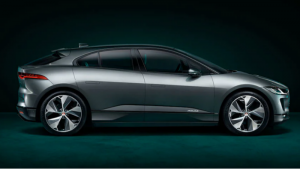
Nick Rogers, Executive Director of Product Engineering, Jaguar Land Rover said: “Our Shannon software development centre is advancing the use of cryptocurrency to make people’s lives better, by allowing drivers to safely share data and make payments from their vehicle. Working with our engineering hub in the UK, the team in Shannon are pioneering and testing these sophisticated connected technologies that will help people to make the most of the time they spend in their car. Jaguar Land Rover is embracing autonomous, connected, electrified and shared mobility technology as we endeavour to make cars safer, cleaner and smarter for everybody.”

The ‘Smart Wallet’
Using ‘Smart Wallet’ technology from the IOTA Foundation, owners will earn credits by enabling their cars to report: to navigation providers and or local authorities, useful road condition data, such as:
- traffic congestion
- potholes
- road works
- other ‘obstacles’ to smooth driving.
Drivers will then be able to redeem these credits for rewards. Drivers will also be able to top-up the ‘Smart Wallet’ using conventional payment methods. Items or services which credits can buy could include:
- refreshments (coffee, tea, water, etc.)
- toll payments
- parking fees
- smart charging of electric vehicles.
In effect the ‘Smart Wallet’ would:
- remove the need for drivers to look for credit cards or other payment mechanisms
- avoid the need to sign up for multiple different vendors and accounts in order to pay for everyday services.
Russell Vickers, Jaguar Land Rover Software Architect, said: “The connected car technologies we are developing will be transformative and truly turn your Jaguar or Land Rover into a third space, in addition to your home or office. In the future an autonomous car could drive itself to a charging station, recharge and pay, while its owner could choose to participate in the sharing economy — earning rewards from sharing useful data such as warning other cars of traffic jams.”

The ‘Smart Wallet’ and backing technology
Experts at the JLR Shannon R&D facility, are developing technologies to support electrification and self-driving features on future Jaguar and Land Rover vehicles. Supported by the Irish Development Agency, the Shannon team is also:
- developing a next generation electrical architecture
- exploring advanced driver assistance systems features for future vehicles.
For the ‘Smart Wallet’, JLR uses cryptocurrency technology via its partnership with the IOTA Foundation to harness ‘distributed ledger’ technologies (DLT or blockchain) to make and receive payments.
Unlike many similar systems, the approach will require no transaction fee to operate. In addition, the plan is that, over time, transactions will become faster across the entire network (which could reach some 75B connected devices by 2025).
Holger Köther, director of partnerships, IOTA Foundation, said: “Our distributed ledger technology is perfectly suited to enable machine-to-machine payments for smart charging, parking and tolls, in addition to creating opportunities for drivers to earn their own digital currency. We are excited to partner with Jaguar Land Rover in implementing its IOTA-powered car wallet, delivering a major convenience benefit for their customers worldwide.”

IOTA and DLT
With the advent of DLT, the IOTA Foundation looks to blockchain to distribute and synchronise ledgers of data and money in secure, distributed and decentralised permissionless environments. By removing the need for trusted third-parties (traditionally the gatekeepers and arbiters of truth) IOTA believes efficiency gains, innovation opportunities and new value propositions emerge.
As such, for IOTA, DLT promises decentralised networks which enable innovation and peer-to-peer transactions without those intermediaries or fees. Yet, the first blockchains solutions often failed to execute as envisioned, due to inherent technical flaws in their design (sluggish transaction times and skyrocketing fees are typical).
By solving the inefficiencies of blockchain, IOTA uses what it believes is a revolutionary approach to DLT: the Tangle. The Tangle is the data structure at the heart of IOTA which uses a DAG instead of a blockchain to store its ledger, with the main motivation being scalability. IOTA’s insight is that a blockchain has an inherent transaction rate limit, because all participants agree on the longest chain, and discard forks and side branches. The Tangle, on the other hand, allows different branches of the DAG to eventually merge, resulting in a much faster overall throughput.
It regards the Tangle as “the missing link for the Internet of Everything and Web 3.0″. By powering a secure, scalable and feeless transaction settlement layer, IOTA hopes to empower machines (like JLR’s vehicles) and humans to participate in new permissionless economies.
Enterprise Times: what does this mean
The technology research behind this initiative forms part of JLR’s Destination Zero strategy. This aims to achieve zero:
- emissions
- accidents
- congestion.
Part of reaching this target is the establishment of a shared economy where vehicles play an integral role as data gatherers for the smart cities of the future. In this context, connected ‘Smart Wallet’ services should promote reductions in congestion via sharing of live traffic situation updates and alternative routing for travellers. For ICE vehicles this should reduce tailpipe emissions when idling in traffic. For EVs it may extend ranges or provide opportunities to recharge while waiting for congestion to clear.
Whether IOTA’s vision for the Tangle and DAG is correct, what the IOTA and JLR partnership indicate is how DLT can penetrate into day-to-day business and consumer functions. How ‘nice’ it would be if, by participating in improving traffic flows (for example) and reducing pollution, one’s car can pay to recharge itself.


























